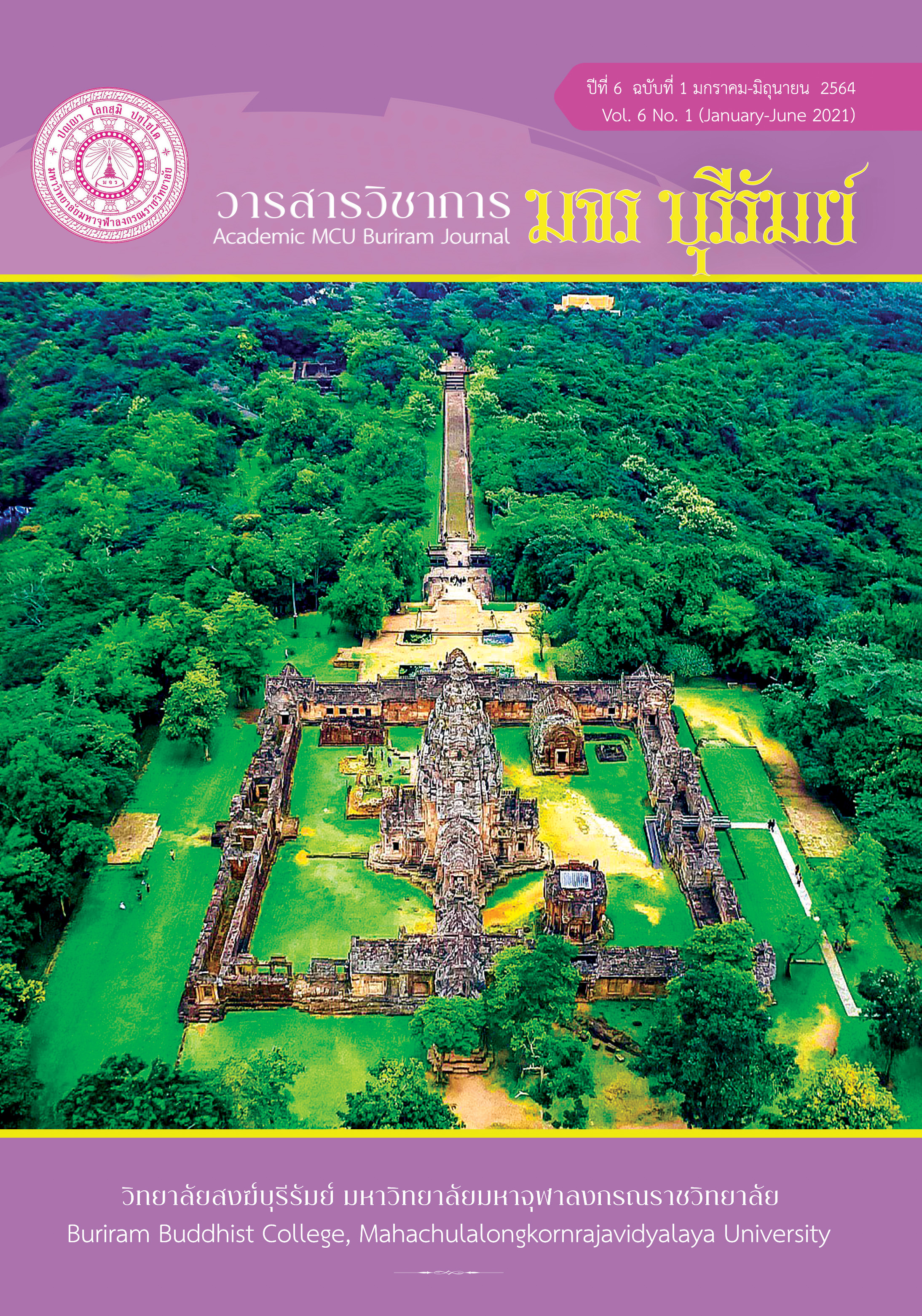แนวทางการปลูกฝังคุณธรรมแก่เยาวชนของศูนย์อบรมคุณธรรมค่ายพุทธบุตร วัดหนองเลิง อำเภอคำเขื่อนแก้ว จังหวัดยโสธร ในสถานการณ์โรคระบาดไวรัสโควิด-19
คำสำคัญ:
การปลูกฝังคุณธรรม, ค่ายพุทธบุตร, โรคระบาดไวรัสโควิด-19บทคัดย่อ
บทความวิชาการนี้ มีวัตถุประสงค์เพื่อสะท้อนมุมมอง 2 ประเด็น คือ 1) เพื่อศึกษาพุทธบริหารและการแก้ไขโรคระบาดของคณะสงฆ์ในสมัยพุทธกาล และ 2) เพื่อศึกษาแนวทางการปลูกฝังคุณธรรมแก่เยาวชนของศูนย์อบรมคุณธรรมค่ายพุทธบุตรวัดหนองเลิง อำเภอคำเขื่อนแก้ว จังหวัดยโสธร ในสถานการณ์โรคระบาดไวรัสโควิด-19 ผลการศึกษา พบว่า การป้องกันการเกิดโรคด้วยข้อปฏิบัติสุขอนามัยในวัตร 14 พระพุทธองค์ได้วางหลักการดำเนินชีวิตที่ดีงามซึ่งนำไปสู่การดูแลป้องกันตัวเองจากทุกข์และโรคภัยไข้เจ็บต่าง ๆ ไม่ว่าจะเป็นธรรมเพื่อส่งเสริมความเป็นมนุษย์ ธรรมเพื่อดำเนินชีวิตให้งอกงาม ธรรมเพื่อส่งเสริมชีวิตที่ดีร่วมกัน และธรรมสำหรับภิกษุสงฆ์ เป็นต้น พระพุทธองค์ได้ตรัสถึงวัตรปฏิบัติที่พูดถึงมารยาท ความสะอาด และความเป็นระเบียบเรียบร้อยของภิกษุสงฆ์ และแนวทางการส่งเสริมให้จัดกิจกรรมอบรมคุณธรรมจริยธรรมในโรงเรียนที่ค่ายพุทธบุตรควรดำเนินการ เช่น การส่งเสริมให้โรงเรียนใช้วันพระเป็นวันอบรมคุณธรรมจริยธรรมสำหรับเด็กและเยาวชน โดยนิมนต์พระสงฆ์จากวัดใกล้โรงเรียนมาบรรยายธรรมหน้าเสาธง การส่งเสริมให้เด็กและเยาวชนฝึกสมาธิ วันละ 5-10 นาที ก่อนเรียนชั่วโมงแรกทุกวัน เพื่อเป็นการปลูกฝังเด็กและเยาวชนได้เรียนรู้การปฏิบัติธรรม เห็นความสำคัญของพระพุทธศาสนาและสามารถนำแนวทางที่ดีไปไปปฏิบัติในชีวิตประจำวัน โดยผ่านระบบออนไลน์หรือการจัดในสถานที่ที่มีการคัดกรองจัดสถานที่ให้ปลอดภัยจากการติดเชื้อระหว่างกันได้
เอกสารอ้างอิง
กรมการศาสนา กระทรวงวัฒนธรรม. (2556). คู่มือการจัดค่ายคุณธรรมเยาวชน. กรุงเทพมหานคร: จัดพิมพ์โดยกรมการศาสนา.
จรรยา ยุทธพลนาวี, ปริยฉัตร เวทยนุกูล และ วิภาวดี โก๊ะเค้า. (2563). ประวัติศาสตร์และวัฒนธรรมการจัดการโรคระบาดในสังคม. ศูนย์มานุษยวิทยาสิรินธร, แหล่งที่มา: https://www.sac.or.th/main/th/article/detail/127 (2 พฤษภาคม 2564).
บีนา กุตติพารามบิล. (2562). พัฒนาเยาวชนให้พร้อมรับมือกับอนาคตได้อย่างมั่นใจ. แหล่งที่มา: https://www.unicef.org/thailand/th/stories/ (1 พฤษภาคม 2564).
พระมหาไพจิตร อุตฺตมธมฺโม. (2563). ภาวะผู้นำเชิงพระพุทธในการแก้ไขปัญหาวิกฤตทางสังคม: กรณีศึกษาโรคระบาด. วารสารพุทธมัคค์, 5(1), 127-137.
พันธุ์ทิพย์ ธีระเนตร. (2563). โรคระบาดในประวัติศาสตร์ไทย เราผ่านพ้นมาได้อย่างไร. แหล่งที่มา: https://www.matichon.co.th/prachachuen/prachachuen-scoop/news (2 พฤษภาคม 2564).
มหาจุฬาลงกรณราชวิทยาลัย. (2535). พระไตรปิฎกภาษาไทย ฉบับมหาจุฬาลงกรณราช
วิทยาลัย. กรุงเทพมหานคร: มหาวิทยาลัยมหาจุฬาลงกรณราชวิทยาลัย.
สรวงมณฑ์ สิทธิสมาน. (2564). เด็กเกิดน้อย ต้องเพิ่มคุณภาพไม่ใช่ปริมาณ. แหล่งที่มา: https://mgronline.com/qol/detail/9640000015703 (1 พฤษภาคม 2564).
arayadusit. (2563). โรคระบาดสมัยพุทธกาล. แหล่งที่มา: https://www.blockdit.com (2 พฤษภาคม 2564).
Wate Bunnakornkul. (2563). ยุบ เลิก โรงเรียนร้าง เด็กเกิดน้อย: สังคมสูงวัย. แหล่งที่มา: http://dhamma.serichon.us/2020/05/31 (1 พฤษภาคม 2564).
ดาวน์โหลด
เผยแพร่แล้ว
รูปแบบการอ้างอิง
ฉบับ
ประเภทบทความ
สัญญาอนุญาต
ทัศนะและความคิดเห็นที่ปรากฏในบทความวารสารฉบับนี้ถือเป็นความรับผิดชอบของผู้เขียนบทความนั้น ไม่ถือเป็นทัศนะและความรับผิดชอบของบรรณาธิการ





